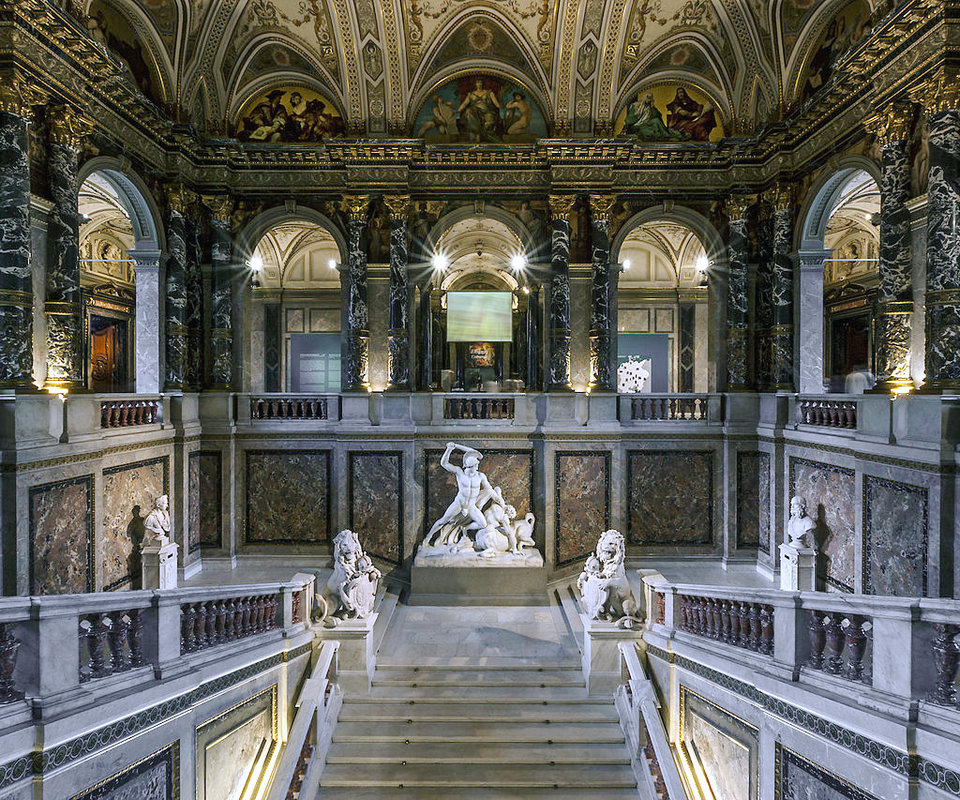The Kunsthistorisches Museum is an art museum in Vienna, Austria. Housed in its festive palatial building on Ringstraße, it is crowned with an octagonal dome. The term Kunsthistorisches Museum applies to both the institution and the main building. It is the largest art museum in the country.
The museum’s primary collections are those of the Habsburgs, particularly from the portrait and armour collections of Ferdinand of Tirol, the collections of Emperor Rudolph II (the largest part of which is, however, scattered), and the collection of paintings of Archduke Leopold Wilhelm, of which his Italian paintings were first documented in the Theatrum Pictorium.
Following the enlargement of Vienna after the demolition of the city walls in the 1860s, the Hofburg had its last great expansion. An Imperial Forum (Kaiserforum) was planned—a two-winged structure reaching beyond the Ringstraße, with the twin museums (Kunsthistorisches Museum and Naturhistorisches Museum as flanks and terminating at the old Imperial Stables of Fischer von Erlach. The museums were completed in 1891, but construction of the rest of the forum dragged on slowly and conflicted since, besides ostentation, no real function could be found for the enormous construction project. In 1913, the south-west wing, the Neue Burg (“New Castle”) was completed. However, the Imperial Forum was never finished. The Neue Burg today houses a number of Collections, that belong to the Kunsthistorisches Museum Vienna: the Ephesus Museum, the Collection of Arms and Armor and the Collection of Ancient Musical Instruments. The Collection of Arms and Armour numbers among the best of its kind in the world. Furthermore, it is the best-documented collection of court arms and armour in the western world, since the exhibits were generally created or acquired in connection with important political occasions: on the occasion of military campaigns, Imperial Diets, ceremonies of homage, coronations, engagements, marriages and baptisms. No family of rulers was connected by marriage with so many European countries as were the Habsburgs. For this reason, nearly all western European princes from the 15th to the early 20th centuries are represented with armour and ornamental weapons. The suits of armour are custom creations made by the most famous armourers: the Armour for a Horseman by Tommaso Missaglia, the Cuirassier Armour by Lorenz Helmschmid for Emperor Maximilian I, the Boy’s Folded Skirt Armour by Konrad Seusenhofer for the future Emperor Charles V, as well as the Half-Armour alla Romana by Filippo Negroli and many others. The often magnificent etchings were quite frequently based on designs by such famous artists as Dürer and Holbein.
It was opened around 1891 at the same time as the Naturhistorisches Museum, by Emperor Franz Joseph I of Austria-Hungary. The two museums have similar exteriors and face each other across Maria-Theresien-Platz. Both buildings were built between 1871 and 1891 according to plans drawn up by Gottfried Semper and Karl Freiherr von Hasenauer.
The two Ringstraße museums were commissioned by the Emperor in order to find a suitable shelter for the Habsburgs’ formidable art collection and to make it accessible to the general public. The façade was built of sandstone. The building is rectangular in shape, and topped with a dome that is 60 meters high. The inside of the building is lavishly decorated with marble, stucco ornamentations, gold-leaf, and paintings.
With its sister building, the Museum of Natural History, the Kunsthistorisches Museum is one of the most important historic buildings of the Ringstraße. Together they stand the Maria-Theresien-Platz (next to the Burgring), where the Maria Theresa Monument stands. This square covers a part of the former Glacis between today’s Ringstraße and Zweierlinie and forms an ensemble monument, which also belongs to the Weltkulturerbe Historic Center of Vienna.
The museum was created from the collections of the Habsburgs, mainly from the collection of portraits and harnesses of Ferdinand of Tyrol, the collection of Emperor Rudolf II (most of which, however, is scattered) and the collection of Archduke Leopold Wilhelm. As early as 1833, Joseph von Arneth, Custos (and later Director) of the Imperial Mint and Antique Cabinet, demanded the consolidation of all imperial collections in a single building.
